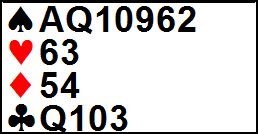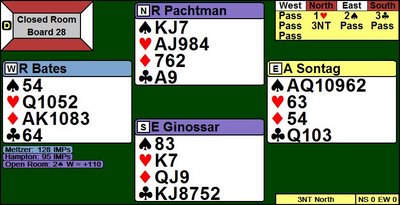Vandy Lead
Fred Gitelman at the end of his comments about the Vandy Lite posting, suggested using BBO's handviewer program. Let's give it a try here, comparing to pictures.
You have:
 .
.
.
.
.
And the bidding is:
 .
.
.
.
Or, the same hand/bidding with handviewer:
What do you lead?
I would like to mention some nice people I know that finished first in their ACBL categories given in the April ACBL bulletin: Heather Peckett, Michael Myers, Claire Zeitoun, and Allan Graves. Nice can finish first! - the other players who finished first may also be nice, I just don't know them personally (e.g. Gavin Wolpert is a great guy, but doesn't update his blog enough for me to be aware of the latest about him).
Also in the April bulletin, Karen Walker continues a terrific new series, "Improve your opening leads", and Jon Shuster writes about Transfers opposite overcalls (TOO - opposite partner's overcall "all bids except for raises, spade bids and 3NT are transfers" including double and redouble).
On the hand above, did you find the lead Alan Sontag made?
Here is the full hand:

.
.
.
.
.
.
If you lead anything but a diamond, 3NT can be made with a club finesse. A diamond lead resulted in down 7!
If you are using TOO, perhaps the West hand could double as a transfer to diamonds, but then does North still bid 3NT?
I tried to embedded the handviewer version of the hand, but the blogger software converted all the (straight line character) in the lin format to nothing, and I can't even link to anything with that character in it. Here's an attempt to link to handviewer without going back to blogger "Compose mode":
Link to handviewer
Now without going back to compose mode, here is the handviewer version:
This seems fine except I have to edit completely with html, which is [not pleasant].
Fred Gitelman at the end of his comments about the Vandy Lite posting, suggested using BBO's handviewer program. Let's give it a try here, comparing to pictures.
You have:
.
.
.
And the bidding is:
.
.
Or, the same hand/bidding with handviewer:
What do you lead?
I would like to mention some nice people I know that finished first in their ACBL categories given in the April ACBL bulletin: Heather Peckett, Michael Myers, Claire Zeitoun, and Allan Graves. Nice can finish first! - the other players who finished first may also be nice, I just don't know them personally (e.g. Gavin Wolpert is a great guy, but doesn't update his blog enough for me to be aware of the latest about him).
Also in the April bulletin, Karen Walker continues a terrific new series, "Improve your opening leads", and Jon Shuster writes about Transfers opposite overcalls (TOO - opposite partner's overcall "all bids except for raises, spade bids and 3NT are transfers" including double and redouble).
On the hand above, did you find the lead Alan Sontag made?
Here is the full hand:
.
.
.
.
.
.
If you lead anything but a diamond, 3NT can be made with a club finesse. A diamond lead resulted in down 7!
If you are using TOO, perhaps the West hand could double as a transfer to diamonds, but then does North still bid 3NT?
I tried to embedded the handviewer version of the hand, but the blogger software converted all the (straight line character) in the lin format to nothing, and I can't even link to anything with that character in it. Here's an attempt to link to handviewer without going back to blogger "Compose mode":
Link to handviewer
Now without going back to compose mode, here is the handviewer version:
This seems fine except I have to edit completely with html, which is [not pleasant].
